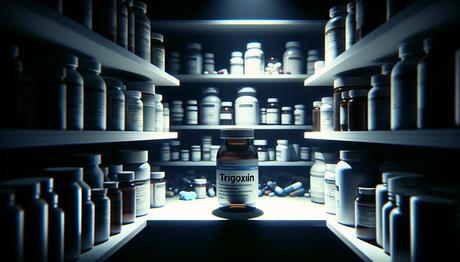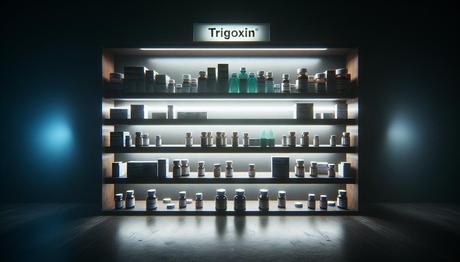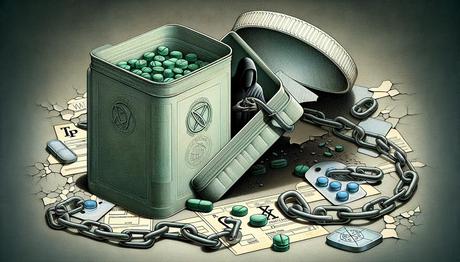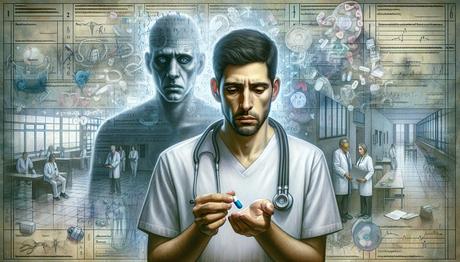The movie ‘Run’ features a made-up drug called Trigoxin, which seems to cause paralysis. This drug is based on a real medicine called Digoxin, which is used for heart problems.
The story in ‘Run’ mixes fact and fiction, and this can make people think differently about real drugs and treatments. When we look at how the movie and real-life heart treatments overlap, we can see how doctors face tough choices and how movies can shape our views on medicine.
We need to separate what’s true from what’s exaggerated in the movie regarding the green pill. It’s important to understand how stories in movies can both mirror and change the way we see healthcare in real life.
Overview of Trigoxin

You’ve likely heard of Trigoxin from the thriller ‘Run,’ but it’s critical to understand that it’s not an actual medication.
It represents a class of drugs with a specific mechanism of action that regulate heart function, much like the real-life drug Digoxin.
Description of Trigoxin: What it is and its medical use
While Trigoxin frequently appears in the narrative of ‘Run,’ it’s important to understand that it’s a fictional drug with no direct medical application in the real world. Here’s what you need to know:
- Digoxin: This is a real medication, unlike Trigoxin, and belongs to a class of drugs known as cardiac glycosides.
- Heart Failure: Digoxin is used to treat heart failure by acting as a positive inotrope, which means it helps the heart muscle contract more forcefully.
- Atrial Fibrillation: It’s also prescribed for atrial fibrillation, a common type of irregular heartbeat, to control the heart rate.
- Mechanism of Action: Digoxin increases the force of cardiac muscle contractions and helps to restore a normal, steady heart rhythm.
Historical development and approval for medical use

Digoxin, the real-life counterpart to the fictional Trigoxin depicted in ‘Run,’ has a rich history dating back to the late 18th century when William Withering, an English botanist and physician, first recognized the medicinal potential of digitalis, the plant from which this drug is derived.
Extracted from the foxglove plant, digoxin belongs to a class of medications known as cardioactive steroids. It’s marketed under various names, including Lanoxin, and is used to treat heart conditions like atrial fibrillation and heart failure.
The discovery of digoxin immune fab, an antidote for digoxin toxicity, underscored the drug’s significance and the need for careful monitoring. Its approval for medical use involved rigorous testing to ensure safety and efficacy for managing specific heart conditions.
How Trigoxin works in the body (mechanism of action)
Building on the historical development of heart medications, let’s examine how Trigoxin, the fictional counterpart to Digoxin in the movie ‘Run,’ is portrayed to function within the body:
- As an inotrope, Trigoxin would increase the force of your heart’s contractions, thereby improving cardiac output and ejection fraction, a measure of how well your heart pumps with each beat.
- It’s shown to modulate calcium channels on heart muscle cells, enhancing contractility, which is the strength of the contraction.
- The fictional drug likely mimics Digoxin’s cardiotonic effects, meaning it helps the heart muscle to contract more efficiently, without expending more energy.
- By doing so, Trigoxin would theoretically support a failing heart, providing symptomatic relief and improved quality of life for those with certain heart conditions.
Is Trigoxin Used For Dogs?

Trigoxin, a medication featured in the movie ‘Run,’ doesn’t exist for dogs or any other animals in real life; instead, its portrayal as a muscle relaxer for canines is purely a fictional element of the film.
In reality, you’ll find that drugs with similar names, like Digoxin, serve as cardiac stimulants in human medicine. They’re used to treat conditions such as atrial fibrillation, ventricular tachycardia, and ventricular fibrillation by improving the heart’s efficiency and controlling its rhythm.
The pharmacokinetics of Digoxin, which is the study of how the drug is absorbed, distributed, metabolized, and excreted in the body, are well-understood in humans.
However, if you’re considering the implications for veterinary use, particularly dogs, the closest counterparts are medications specifically formulated for animal physiology and conditions.
These drugs can also have complex drug interactions, which veterinarians carefully consider when prescribing treatment for cardiac issues in pets.
The film ‘Run’ uses Trigoxin as part of its story, but in actual veterinary care, heart medication is important and based on scientific evidence for each specific animal.
Is Trigoxin: Is the Medicine in Hulu’s Movie “Run” Real?

While the portrayal of Trigoxin in ‘Run’ as a canine muscle relaxer is purely fictional, the question arises whether this medicine has any basis in reality or if it’s a complete fabrication for cinematic intrigue.
Here’s what you should know:
- Cardiac Rhythm: Digoxin, the real-life counterpart of Trigoxin, plays a critical role in managing cardiac rhythm, particularly in patients with arrhythmia.
- Arrhythmia Treatment: Although Trigoxin itself isn’t real, Digoxin is indeed used to treat various cardiac conditions, including arrhythmias, by improving the heart’s efficiency and controlling its rate.
- Toxicity Risks: With Digoxin, the therapeutic window is narrow, meaning there’s a fine line between the effective dose and toxicity. An overdose can lead to serious complications, which might echo the severe effects depicted in the movie.
- Medication Adherence: Digoxin requires strict medication adherence to avoid the risks associated with overdose, underscoring the importance of following prescribed dosages closely.
It’s clear that while Trigoxin is a fictional element created for ‘Run’, its depiction draws on real-world medication characteristics and the serious implications of disregarding proper medication adherence and the dangers of toxicity.
What Is Trigoxin and the Green Pill, and Are They Real Medications?

You might find yourself wondering whether Trigoxin and the green pill portrayed in ‘Run’ are actual medications or merely fictional creations for dramatic effect.
Trigoxin, while sounding convincing, doesn’t exist in the pharmacopeia. It’s a fabrication, inspired by Digoxin, a real drug with specific pharmacodynamics. Digoxin influences the atrioventricular node, managing conditions like atrial fibrillation and heart failure. It can cause side effects such as bradycardia and vision changes, which filmmakers could have thought fitting for the narrative’s tension.
The green pill, intriguing in its depiction, is also not a real medication. In the film, it’s suggested to affect muscle function, which could imply an influence on neuromuscular biomarkers. However, in reality, no such green pill exists with the properties shown in ‘Run’. The choice of color and effects seems designed to intrigue and mislead, aligning with the movie’s suspenseful theme.
In short, both Trigoxin and the green pill are fictional. They serve as plot devices, not reflections of genuine medical treatments, and their purported effects aren’t grounded in clinical reality.
Digoxin Oral: Effects, Videos, Interactions, Uses, Cautions, Pictures & Dosage

Digoxin oral medication, commonly prescribed for heart conditions, directly influences the efficiency and rhythm of your heart’s contractions, and must be used with caution due to its potential interaction with other drugs and side effects.
When you’re taking digoxin, it’s crucial to understand its effects on your cardiac electrophysiology—the way your heart’s electrical system functions.
Here are important considerations to keep in mind:
- Serum Potassium Levels: Low serum potassium (hypokalemia) increases the risk of digoxin toxicity. It’s essential to monitor your potassium levels to ensure they stay within a safe range.
- Serum Magnesium Balance: Like potassium, serum magnesium is important for maintaining heart rhythm. Magnesium deficiency can exacerbate digoxin’s effects.
- Cytochrome Enzymes: Digoxin is metabolized by cytochrome enzymes in the liver. Other drugs that affect these enzymes can alter digoxin levels and its efficacy.
- Dosing Precision: The therapeutic range for digoxin is narrow. You must follow the prescribed dosage closely and attend regular follow-ups for dose adjustments based on your response and blood tests.
Is the Trigoxin Pill Real?

Understanding the precise nature and effects of medications like Digoxin is crucial, especially when confronting the question of whether the Trigoxin pill, a prominent element in the film ‘Run,’ has any basis in reality.
To clarify, the Trigoxin pill isn’t real. It’s a fictional drug meant to resemble Digoxin, which is indeed a legitimate medication. Digoxin is used to manage heart conditions such as atrial fibrillation and heart failure by influencing the heart rate and strengthening cardiac contraction.
Analyzing the portrayal in ‘Run,’ we see a stark divergence from clinical reality. In the movie, Trigoxin is incorrectly shown as a muscle relaxer, which isn’t a function of Digoxin.
In real life, Digoxin can have side effects such as hypokalemia (low potassium levels), which can exacerbate the drug’s actions, leading to a slower heart rate or even hypotension (low blood pressure).
It’s also contraindicated in certain conditions, and overdose might cause visual disturbances, often described as seeing halos around lights.
Thus, while ‘Run’ uses Trigoxin for dramatic effect, it’s essential to distinguish between the fictional depiction and the real-life implications of medication like Digoxin.
Medical Uses of Trigoxin

You may find it intriguing that while Trigoxin is a fictional drug in ‘Run’, its counterpart, Digoxin, is a well-established medication for various heart conditions.
It’s essential to understand the appropriate dosage and administration of Digoxin, as it significantly impacts heart function and can be life-saving for those with atrial fibrillation or heart failure.
However, you must also be aware of its potential side effects and contraindications, which, if ignored, can lead to severe complications.
Primary indications: Heart conditions treated with Trigoxin
While Trigoxin is a fictional drug depicted in the movie ‘Run,’ it mirrors the medical uses of Digoxin, which is primarily prescribed for treating various heart conditions such as atrial fibrillation and heart failure.
The list below highlights the conditions and factors considered when using Digoxin:
- Atrial Fibrillation: It helps slow down the heart rate, improving symptoms and quality of life.
- Heart Failure: Increases the force of cardiac contractions, aiding in symptom management.
- Troponins and Hyperkalemia: Monitoring is essential as Digoxin can affect electrolyte levels, impacting heart function.
- Kidney Disease and Drug Interactions: Dosage adjustments may be necessary for patients with renal impairment. Careful consideration is given when used alongside other medications like amiodarone, which can raise Digoxin levels, and with p-glycoprotein inducers, which can decrease its effectiveness.
Dosage and administration
As we consider the heart conditions treated with Trigoxin, it’s crucial to examine how the dosage and administration of this medication can impact its effectiveness and safety.
The precise dosage of Digoxin, which Trigoxin mirrors, is dependent on the patient’s condition, kidney function, and response to treatment. Overdosage can lead to toxicity, characterized by nausea, vomiting, and heart rhythm disturbances.
It’s typically administered orally, but can also be given intravenously. The indication for use is critical; Digoxin is often prescribed for atrial fibrillation and heart failure.
Importantly, drugs like diltiazem and verapamil can interact with Digoxin, necessitating careful monitoring and possible dosage adjustments to avoid adverse effects and ensure therapeutic efficacy.
Side effects and contraindications
Delving into the medical uses of Trigoxin, it’s essential to understand that, despite its fictional status, possible side effects and contraindications would likely mirror those of its real-world counterpart, Digoxin.
Here’s what you should be aware of:
- Nausea and Vomiting: These are common side effects, indicating potential toxicity, especially if persistent.
- Cardiac Disturbances: Digoxin can cause arrhythmias, which might be life-threatening if not monitored.
- Visual Changes: Users may experience blurred vision or see halos around lights, a sign of digoxin toxicity.
- Electrolyte Imbalance: Careful attention to potassium levels is crucial, as low levels increase toxicity risk.
Always consult a healthcare professional before starting any new medication, and be vigilant about monitoring for side effects.
Trigoxin in Popular Media: The Movie ‘Run

In the movie ‘Run’, you’re introduced to Trigoxin, a fictional drug that plays a pivotal role in the plot’s tension.
The film’s depiction of Trigoxin as a harmful substance contrasts sharply with the real-world medical application of its counterpart, Digoxin, which is used to treat heart conditions.
This portrayal prompts a critical look at how cinematic narratives can shape public perception of pharmaceuticals, often diverging from their actual therapeutic purposes.
Overview of the movie “Run” with a focus on the depiction of Trigoxin
The psychological thriller ‘Run’ has garnered attention for its portrayal of Trigoxin, a fictitious drug with significant implications for the film’s main characters. Here’s what you should know about its depiction:
- Fiction versus Reality: Trigoxin resembles real-life Digoxin, a heart medication, but its use in the film is exaggerated for dramatic effect.
- Mother’s Motive: The drug is administered by the overprotective mother, suggesting Munchausen syndrome by proxy, where a caregiver fabricates or induces illness in a person under their care.
- Chloe’s Condition: The protagonist, Chloe, is made to believe she’s ill, which underscores the psychological manipulation inherent in the plot.
- Plot Device: Trigoxin is crucial to the narrative, serving as a symbol of control and deception that unravels the dark truths within the story.
Analysis of how Trigoxin is portrayed in the film
While Trigoxin in ‘Run’ mirrors the real-life medication Digoxin, its portrayal in the film amplifies its effects to serve as a pivotal element of suspense and psychological manipulation.
The movie exaggerates Trigoxin’s capabilities, depicting it as a paralytic agent rather than merely a heart medication. This creative liberty intensifies the drama and anchors the film’s central conflict. It’s clear that while Digoxin can have severe side effects when misused, Trigoxin’s representation is hyperbolized for narrative impact.
By doing so, the film underscores the potential dangers of medication misuse, albeit in a fictional context, and spotlights the ethical dilemmas surrounding caregiving and medical trust.
The heightened effects of Trigoxin are crucial for driving the story’s tension and raising questions about medical safety and deception.
Differences between the film’s portrayal and real-world medical use
Frequently, films like ‘Run’ take creative liberties with medical portrayals, and Trigoxin’s exaggerated effects diverge significantly from Digoxin’s actual use in treating heart conditions. Here’s how the two differ:
Purpose:
- Digoxin treats heart failure and atrial fibrillation, improving heart efficiency and controlling its rhythm.
- Trigoxin is depicted as a paralyzing agent.
Dosage:
- Digoxin is carefully dosed to avoid toxicity, with blood levels monitored.
- The film suggests a more reckless application of Trigoxin.
Side Effects:
- While Digoxin can have serious side effects if improperly used, it doesn’t induce paralysis like the fictional Trigoxin.
Administration:
- Digoxin is used in human medicine, not as a muscle relaxant for dogs as Trigoxin is portrayed.
The Impact of Media Representation on Public Perception

You mightn’t realize it, but the movies you watch can shape your understanding of medical treatments and drugs.
When films like ‘Run’ portray fictional drugs such as Trigoxin with dramatic effects, they can misinform audiences about the realities of similar, real-life medications.
It’s crucial for media to balance storytelling with accurate depictions of medical interventions, as these narratives contribute to public awareness and can influence perceptions of healthcare practices.
Discussion on how movies influence public perception of medical drugs
Movies like ‘Run’ can significantly shape the public’s understanding and fears regarding medical drugs, often without a basis in scientific reality. Here’s how:
- Misinformation: Fictional portrayals can mislead you into believing inaccurate drug effects, creating unwarranted fear or false security.
- Stigmatization: Dramatic narratives may stigmatize certain medications, deterring their use even when beneficial.
- Influence on Behavior: You might self-diagnose or avoid necessary treatments based on movie-induced misconceptions.
- Public Discourse: Films can spark dialogue, but they often emphasize narrative over fact, skewing public perception and policy debates.
It’s crucial to critically evaluate such depictions and rely on actual medical advice rather than dramatized fiction.
The importance of accurate representation of medical treatments in media
While films like ‘Run’ often prioritize drama over accuracy, it’s vital that media portrayals of medical treatments reflect real-world implications to inform and educate viewers responsibly. Your understanding of medications and their effects can be significantly shaped by what you see on screen.
When drugs like the fictional Trigoxin are depicted inaccurately, it can lead to misconceptions about their real-life counterparts, in this case, Digoxin. It’s crucial that filmmakers balance the need for compelling narratives with the responsibility of accurate representation.
Misrepresentation can cause viewers to underestimate the risks associated with certain medications or to misunderstand their use, potentially leading to dangerous self-diagnosis or misuse.
Always remember, the dramatized version of medicine you see in media should be critically evaluated against verified medical information.
Safety and Regulations Surrounding Trigoxin

You need to understand that while Trigoxin in ‘Run’ is a fictional drug, real-life equivalents like Digoxin are tightly regulated and can only be prescribed by healthcare professionals. Adhering to the prescribed dosage and medical advice is crucial because misuse or abuse poses significant risks to your health.
It’s important to recognize that self-medication or altering prescriptions can lead to severe, even life-threatening consequences.
Regulations and guidelines for prescribing Trigoxin
Considering Trigoxin is a fictional medication created for the movie ‘Run,’ there are no real regulations or guidelines for its prescription. However, if you’re curious about the controls around similar real-life medications, like Digoxin, here’s what you need to know:
- FDA Approval: Prescription drugs must gain FDA approval, which includes rigorous testing for safety and efficacy.
- Prescription Guidelines: Doctors follow specific guidelines when prescribing, considering the patient’s condition and medical history.
- Pharmacy Checks: Pharmacists check for potential drug interactions and correct dosages.
- Monitoring: Patients on heart medications are regularly monitored for therapeutic levels and adverse effects.
Importance of adherence to prescription and medical guidance
Adhering strictly to medical prescriptions and guidance is crucial for ensuring the safety and effectiveness of any treatment, including those involving medications like Digoxin. Digoxin served as the inspiration for the fictional Trigoxin in the movie ‘Run’.
Digoxin belongs to the cardiac glycosides class and has a narrow therapeutic window. This means that the range between an effective dose and a toxic one is small. Deviating from the prescribed dosage can lead to serious complications, such as arrhythmias or toxicity.
Your healthcare provider’s instructions are based on a careful evaluation of your condition, including factors like kidney function and potential drug interactions. Ignoring these guidelines not only jeopardizes your health but can also diminish the drug’s intended benefits.
This emphasizes the importance of a disciplined approach to medication management.
Risks associated with misuse or abuse of Trigoxin
It’s important to know the dangers of misusing or abusing Digoxin, a real drug similar to the made-up Trigoxin. Digoxin has a small safety range and can cause serious heart problems.
- Toxicity Risk: Even small excesses above the therapeutic dose can lead to digoxin toxicity, which can cause nausea, dizziness, and even life-threatening arrhythmias.
- Electrolyte Imbalance: Misuse can disrupt potassium levels, increasing the risk of toxicity.
- Renal Function: Patients with impaired kidney function are more susceptible to adverse effects, as digoxin is primarily excreted by the kidneys.
- Drug Interactions: Combining digoxin with other drugs can increase the risk of toxicity, especially with medications affecting heart rhythm or blood levels of digoxin.
Always follow your doctor’s instructions to avoid these serious risks.
Comparative Analysis

The medication Trigoxin in the movie ‘Run’ is similar to the actual heart drug Digoxin in terms of name and purpose. It is important to evaluate Trigoxin’s effectiveness and side effects against other heart disease treatments.
This comparison not only informs you about Trigoxin’s place in therapeutic options but also highlights the importance of understanding the potential risks and benefits associated with its real-life counterpart, Digoxin.
Comparison of Trigoxin with other similar heart medications
While Trigoxin is a fictional drug from the movie ‘Run,’ its real-life counterpart, Digoxin, shares similarities with other cardiac glycosides used to treat heart conditions, offering a basis for comparison in terms of usage, effects, and side effects.
Here’s how Digoxin stacks up against other medications:
- Therapeutic Range: Digoxin has a narrow therapeutic index, similar to other cardiac glycosides, requiring careful monitoring to avoid toxicity.
- Efficacy: Like other heart failure medications, it improves symptoms and exercise tolerance but doesn’t necessarily reduce mortality.
- Side Effects: It shares common side effects such as nausea and arrhythmia with other cardiac medications, though the risk profile may vary.
- Interactions: Digoxin interacts with a broad range of drugs, just as other heart medications do, necessitating vigilant management of polypharmacy.
Advantages and disadvantages of Trigoxin relative to alternatives
Building upon the comparison of Digoxin with similar heart medications, it’s crucial to examine the fictional Trigoxin’s pros and cons in contrast to its real-life alternatives to understand its potential impact if it were real.
If Trigoxin mirrored Digoxin’s effects, it could benefit patients with heart conditions, as Digoxin improves cardiac output and controls rhythm.
However, as depicted in ‘Run,’ Trigoxin’s exaggerated side effects, like paralysis, are starkly negative when compared to actual medications like Digoxin, which has manageable side effects under medical supervision.
In reality, Digoxin’s disadvantages are its narrow therapeutic index and potential toxicity, necessitating close monitoring.
Thus, Trigoxin’s portrayal amplifies the risks without a balanced view of therapeutic benefits, skewing perceptions of its real-life counterpart.
Patient Experiences and Case Studies

You might be curious about how patients in the real world respond to Digoxin, the medication that Trigoxin fictionally represents in ‘Run’.
Studies show that while Digoxin can be effective for heart conditions, its narrow therapeutic index requires careful monitoring to avoid toxicity.
Patient testimonials often highlight the necessity for regular check-ups to ensure the drug’s efficacy and to mitigate potential side effects.
Real-life case studies or testimonials of patients using Trigoxin
Exploring real-life case studies or testimonials of patients using Trigoxin isn’t possible, as Trigoxin is a fictional drug created for the movie ‘Run’ and doesn’t exist in actual medical practice. However, we can examine the implications of its real-world counterpart, Digoxin, through the lens of evidence-based analysis:
- Efficacy: Clinical studies show that Digoxin improves cardiac output and eases symptoms in heart failure patients.
- Risks: It has a narrow therapeutic index, requiring close monitoring to prevent toxicity.
- Management: Patient testimonials often highlight the importance of regular blood tests to adjust dosages.
- Alternatives: Some case studies mention switching to other medications due to side effects or ineffectiveness of Digoxin.
Discussion of the drug’s efficacy and patient satisfaction
Numerous patient experiences and case studies reveal that while Digoxin is often effective in improving heart function, individual reactions and satisfaction levels can vary significantly.
You should be aware that Digoxin, a cardiac glycoside, has been a mainstay in treating certain heart conditions, including atrial fibrillation and heart failure. Its efficacy hinges on precise dosing and regular monitoring, as its therapeutic window is narrow, and toxicity can occur.
Research indicates that patients who adhere to prescribed Digoxin regimens and are closely monitored often report improved symptoms and quality of life. However, some experience side effects such as nausea, dizziness, or visual disturbances, which can impact satisfaction.
Given these factors, it’s crucial for you to maintain open communication with your healthcare provider about Digoxin’s effects on your health.
Ethical Considerations in Pharmaceutical Representation

You must recognize the ethical responsibilities filmmakers hold when portraying medical drugs in cinema.
Accurate representation is crucial, as fictional narratives can significantly impact public perception and understanding of pharmaceuticals.
As a healthcare professional, it’s your duty to provide clear and factual information to counter any misconceptions that may arise from such portrayals.
Ethical responsibilities of filmmakers when depicting medical drugs
When filmmakers depict medical drugs in movies, they bear an ethical responsibility to balance dramatic effect with responsible representation, as inaccurate portrayals can lead to public misconceptions about the effects and uses of actual medications. Here’s what you need to consider:
- Accuracy: Ensure the drug’s effects and medical applications are represented truthfully to avoid misinformation.
- Impact: Recognize the potential influence on audience perceptions, particularly relating to drug safety and efficacy.
- Consultation: Seek expert advice to portray medical content authentically, reducing the risk of perpetuating myths.
- Responsibility: Be aware of the social responsibility that comes with storytelling, aiming to educate while entertaining.
The role of healthcare professionals in providing accurate information
In the context of pharmaceutical representation, healthcare professionals must provide accurate and evidence-based information to patients, ensuring informed decision-making regarding medication use.
When discussing medications like Digoxin, the real-life counterpart to the fictional Trigoxin, it’s crucial you’re aware of its indications, mechanisms, potential side effects, and contraindications.
Your responsibility extends beyond the prescription; you must elucidate the realistic expectations and risks associated with the medication. Misrepresentation or omission of information can lead to serious health repercussions and undermine patient trust.
It’s imperative that you remain vigilant against biases, especially those stemming from pharmaceutical influences, to maintain the integrity of your guidance and uphold the ethical standards of your profession.
Wrapping Up
In wrapping up, you’ve uncovered that Trigoxin from ‘Run’ is a fictional twist on Digoxin, a genuine heart medication. While the film amplifies drama, it’s crucial you understand the gravity of such drugs in reality.
Digoxin’s use demands strict adherence to medical guidance due to its narrow safety margin.
Your dive into this topic highlights the necessity for ethical pharma portrayals and awareness of the real-world impact such narratives can have on patient perspectives.
